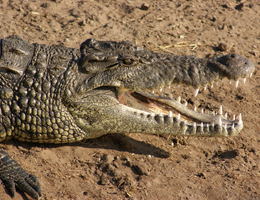Hox genes provide a backward look
A study of the embryonic development of the Nile crocodile’s axial skeleton reported by LMU paleontologists sheds new light on a phase of vertebrate evolution that dates back hundreds of millions of years.
17.09.2015

The genetic program that directs the early development of the axial skeleton in the Nile crocodile shows striking similarities to the pattern of gene activity postulated to have specified the structure of the vertebral column in the last common ancestor of birds and crocodiles – a basal archosaur. This is the central finding of a new study carried out by a research team led by Gert Wörheide, Professor of Palaeontology and Geobiology at LMU which appears in the international journal “Evolution & Development”. Foto: PRILL Mediendesign / fotolia.com
The development of the axial skeleton in vertebrates is regulated by a specific set of so-called Hox genes that code for transcription factors which themselves serve to switch other genes on and off. The spatiotemporal pattern of Hox gene activity determines the form of the vertebrae formed at different axial levels in the vertebral column. Although the anatomy of the vertebrae that make up the axial skeletons of vertebrate species display a wide range of diversity, the set of Hox genes that control their morphology is highly conserved. As a general rule, Hox genes are expressed in an anteroposterior sequence that corresponds to their relative position within each of four gene clusters. Specific Hox genes are expressed in particular regions within the developing vertebral column, whose anterior boundaries are sharply defined, while their posterior limits are more diffuse. Because their action is restricted to quite precisely demarcated segments of the vertebrate backbone that differ in their detailed morphology, the spatial pattern of Hox gene activity during embryonic development is characteristic for the group of vertebrates considered. In their new study, Gert Wörheide and his colleagues provide a detailed description of the pattern of Hox gene activity in the Nile crocodile (Crocodylus niloticus). “Our data complement the findings of an earlier study of the American alligator, allowing us to deduce the so-called Hox code used by all crocodilians,” he says.
Expression domains mirror evolutionary change
The LMU team also compared the pattern of Hox gene expression in crocodiles with those found in birds and mammals. This revealed that the Nile crocodile activates essentially the same subsets of Hox genes in corresponding regions along the anteroposterior axis as do the other vertebrates. Nevertheless, expression patterns in the three taxonomic classes exhibit distinct differences. Crocodiles display much less region-specific variation in vertebral morphology than birds or mammals, with diversification of vertebrae being essentially confined to the anterior end of the axial skeleton and the transition between cervical and dorsal regions. Accordingly, their Hox genes are expressed in broad, overlapping domains. In mammals and birds on the other hand, subsets of Hox genes are expressed in expanded regions as defined clusters. This is particularly striking in the cervical (neck) region in birds and in the thoracic vertebrae of mammals. Notably, these are the axial regions that have been subjected to the most striking modifications during the evolution of the two classes.
The authors therefore interpret the differences in Hox gene expression between crocodilians, birds and mammals as reflecting the anatomical changes that the axial skeleton has undergone during vertebrate diversification. In comparison with the morphological specialization of the axial skeleton of birds and mammals, the vertebral column of the crocodilians has remained relatively uniform. “Our results suggest that the pattern of Hox gene expression in the last common ancestor of crocodiles and birds was probably very similar to that seen in modern crocodiles,” says Christine Böhmer, first author of the new study. “During the subsequent evolution of birds and mammals, the spatial pattern of Hox activity was modified by mutation in ways that gave rise to the regional differences in vertebral morphology which now distinguish these two classes from crocodiles and each other, while the number of genes employed has remained stable.“
The LMU team now plans to characterize Hox expression patterns in other vertebrate species, with a view to gaining further insights into the relationship between changes in the regulation of these developmentally crucial genes and the structural diversification of the vertebrate axial skeleton.

